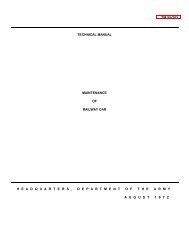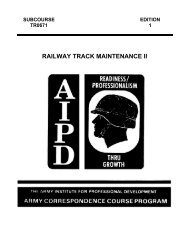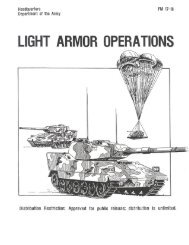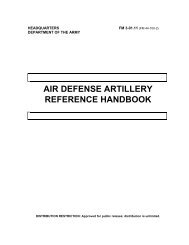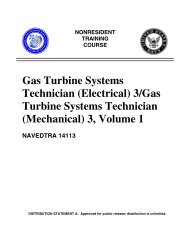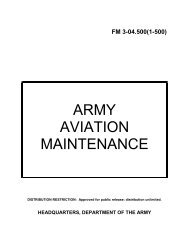fm 44-100 us army air and missile defense operations
fm 44-100 us army air and missile defense operations
fm 44-100 us army air and missile defense operations
Create successful ePaper yourself
Turn your PDF publications into a flip-book with our unique Google optimized e-Paper software.
Appendix C<br />
Space Support<br />
This appendix gives a summary of space support to <strong>air</strong> <strong>and</strong> <strong>missile</strong><br />
<strong>defense</strong> <strong>operations</strong>. It is not intended as a comprehensive guide. FM <strong>100</strong>-<br />
18 establishes doctrine for the Army's <strong>us</strong>e of space, describes current<br />
space system capabilities, <strong>and</strong> provides guidance for the <strong>us</strong>e <strong>and</strong><br />
application of space-based assets in support of Army <strong>operations</strong>.<br />
SPACE FUNDAMENTALS<br />
C-1. Underst<strong>and</strong>ing space fundamentals will aid the <strong>us</strong>er in selecting the best<br />
space support. Orbital characteristics <strong>and</strong> space system limitations are two of<br />
the fundamentals.<br />
ORBITAL CHARACTERISTICS<br />
C-2. Generally, the orbital characteristics of a space system are related to the<br />
function of the satellite. Satellites may be in circular or elliptical orbits that<br />
vary in altitude from 200 miles to over 22,500 miles from the earth's surface.<br />
Low orbits, being closer to the earth, best support-sensing requirements. The<br />
disadvantages of a low orbit are a limited field of view of the earth <strong>and</strong> a<br />
short station time over any given earth area. As altitude increases, so do the<br />
field of view <strong>and</strong> station time, but the ability to resolve a small object<br />
decreases at higher altitudes.<br />
C-3. The time it takes to complete one complete revolution of the earth is<br />
known as the orbital period. The period relates directly to the orbit's average<br />
distance from earth <strong>and</strong> is a function of the satellite's velocity. The greater<br />
the velocity imparted to the satellite during orbital insertion, the greater the<br />
orbital period <strong>and</strong> average distance from earth. Orbital periods range from 90<br />
minutes for the lowest orbits to 24 hours or more for deep space orbits.<br />
C-4. Another element of a satellite's orbit is its inclination, which is the angle<br />
at which the satellite's orbital plane crosses the equator. A higher inclination<br />
generally means that more of the earth's surface is covered. A polar orbit,<br />
with an inclination of 90 degrees, crosses all latitudes, while lesser or greater<br />
inclinations only provide coverage for increasingly higher latitudes,<br />
particularly for satellites in low earth orbits.<br />
C-5. The length of time between satellite coverage of a particular earth<br />
location, that is, the satellite's revisit time, depends upon a number of factors.<br />
For any given satellite, revisit time depends upon both orbital period <strong>and</strong><br />
inclination. For earth coverage by like systems, revisit time also depends<br />
upon the number of satellites in the constellation, the capabilities of the<br />
satellites' payloads, <strong>and</strong> the footprints of the vario<strong>us</strong> onboard sensors.<br />
C-1




